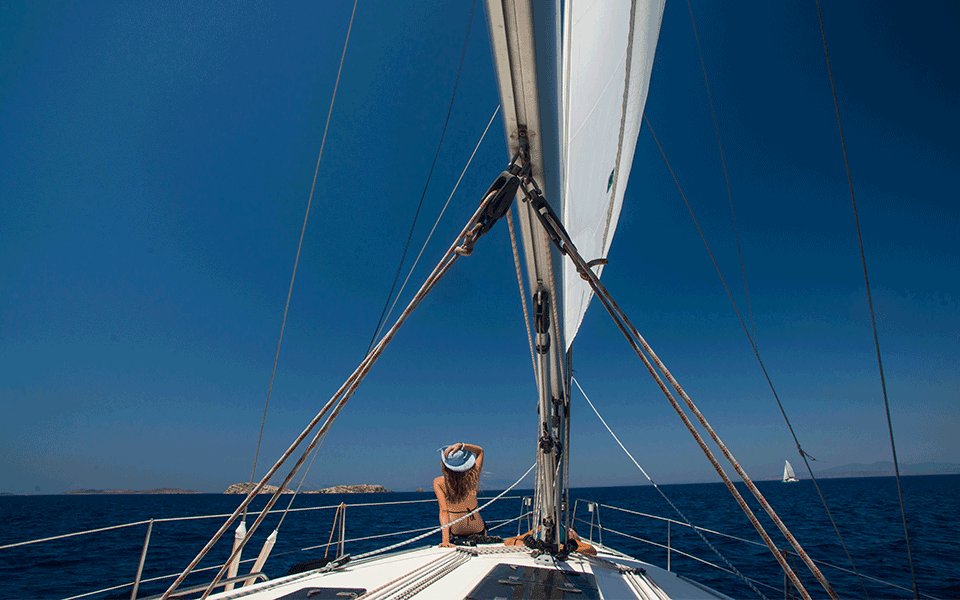Things are pretty busy down at the marina in Kos. Sail and motorboat crews are coming and going, stocking up on supplies, checking engines and studying charts.
Giorgos Kintis and Christos Mylonas from Istion Yachting give us a tour of our vessel, a handsome Bavaria 45 named Johnny, which we consider to be a good omen because, as they say in Greek, spiti horis Yianni prokopi den kanei (a house without a Yiannis [John] doesn’t prosper) – perhaps this is even more true with a vessel!
A reliable and growing enterprise, Istion is a company born-and-bred in the Dodecanese. Its story began here on Kos, which has long been popular among recreational sailors thanks to its marina, which offers a full range of services.
Kintis and Mylonas show us the vessel’s ropes and winches; they tell us to watch out for the reefs on our way out of Kos’ harbor. I don’t even hear them; all I can do is look at the moorings with impatience.
Professional skipper Menelaos Sykomitis is the vessel’s captain, while first mate is Kostas Moschos, whose team has topped the International Aegean Sailing Rally a whopping seven times. And so we slip our moorings and make our way out of the marina – and with a celebratory air no less, thanks to the special boat that accompanies us. We’ve barely gotten underway when the sea lashes us in the face with spray. A fine start.
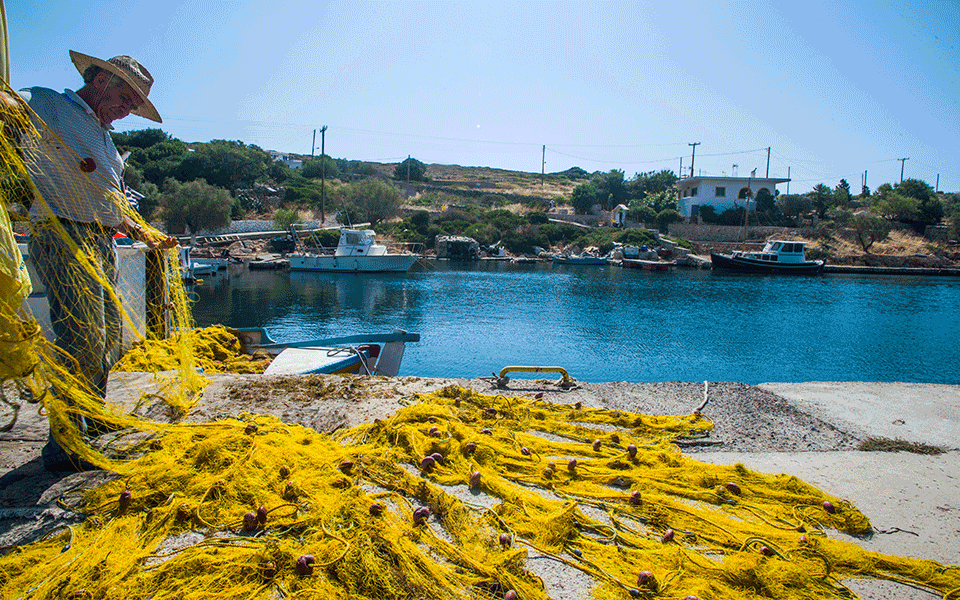
© Clairy Moustafellou
NORTHWARD BOUND
The GPS says that we’re now sailing inside Turkish territorial waters – this is the reason why vessels in the Dodecanese not only bear a Greek flag, but a Turkish one as well. We’re sailing upwind, with the wind against our prow at 0 degrees, which means that we don’t open our sails, relying on the engine instead, in order to avoid having to tack back and forth.
We’re on a northward course. The coastline next to us passes slowly, while, on our other side, seabirds glide and a light breeze gently hits us. The feeling is one of absolute freedom.
We enjoy six hours of calm sailing, right next to islands. On the one side there’s Kalymnos, Pserimos and Leros, on the other there’s Kalolimnos, Imia and Turkey – the last so close that you can pretty much make out each individual house in the city of Bodrum.
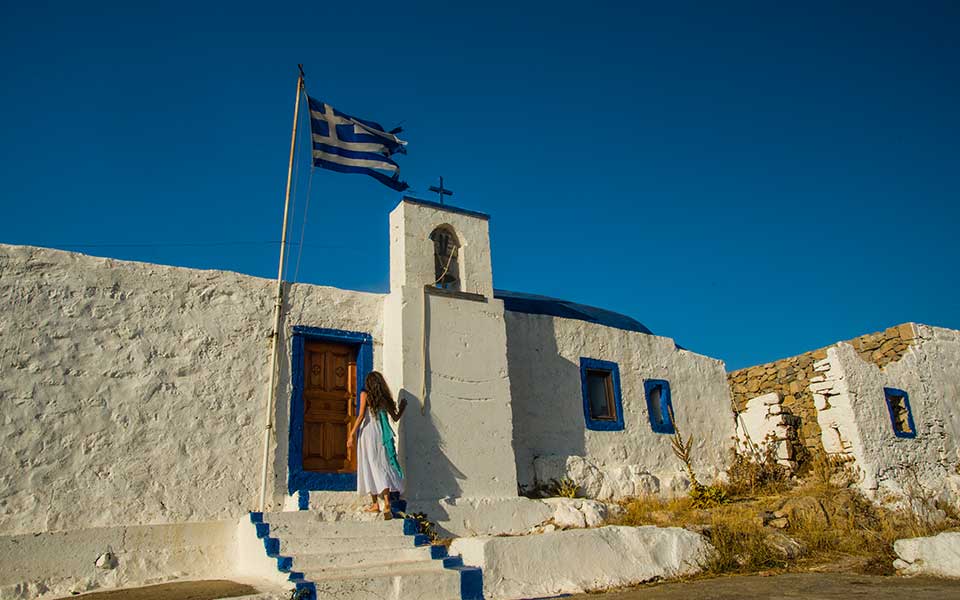
© Clairy Moustafellou
And this is precisely the Dodecanese’s big advantage in the eyes of sailors: you can reach dry land at practically any moment, whether out of necessity or a desire to get to know a new place.
But there’s another reason, too: with the exception of a few challenging straits here and there, the wind is predominantly strong and steady from a northwesterly direction.
We arrive at the harbor of the islet of Arki. There is green wherever one looks, the landscape filled with olive trees wild and cultivated together with pines. The cicadas are deafening.
There are five boats moored inside the tiny harbor. We tie up easily against a small pier – Greeks on the one side, French on the other. Generally speaking, the area is a favorite among foreign visitors, especially those on pleasure boats.
Arki has a couple of tavernas, a cafe, a little shop selling handmade gift items – and not much else. There’s no electricity or water for your boat, either. If you want to stretch your legs, you can hike up as far as the little church of Panaghia Pantanassa, and then gaze at the commanding view from up high.
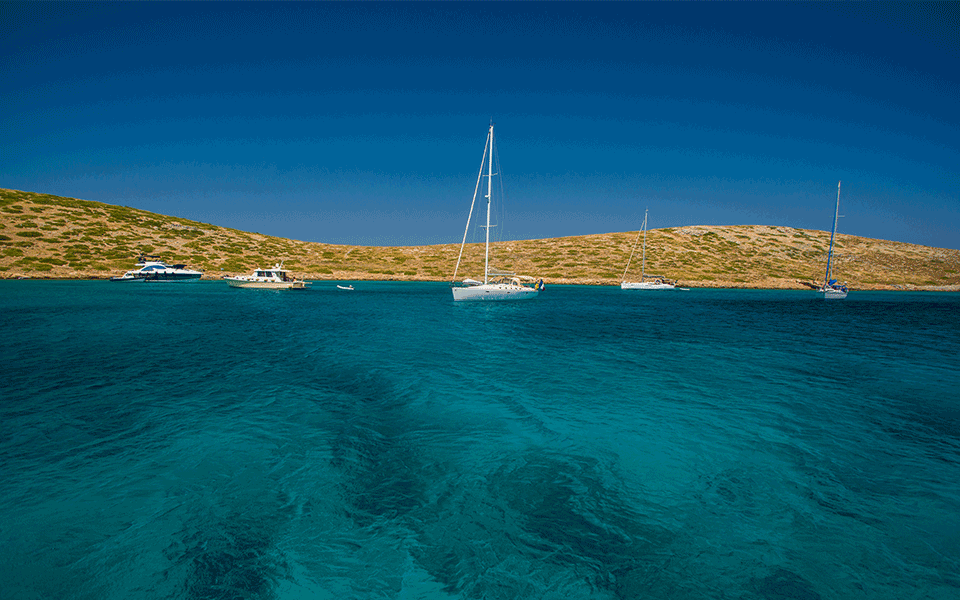
© Clairy Moustafellou
Good spots for a dip are Piso Patelia Beach (a 10-minute walk from the port), Limnari (20 minutes on foot) and Tiganakia, a veritable paradise with deep blue waters only accessible by boat. Here we encounter anchored catamarans, yachts and inflatable vessels, basking in the dead calm found in the space between the islets of the same name. We drop our tender into the water and head for shallower waters. The little beaches look as if they haven’t been stepped on in years, with turquoise waters and smooth pebbles. Our swim is unforgettable.
At night in the harbor, all roads lead to Trypas (tel +30 22470.322.30), the taverna owned by Manolis Melianos. The atmosphere is laid-back, with tsipouro (a pomace brandy), and wonderful local goat and cheese (on Arki they raise animals).
A power outage suddenly plunges the entire settlement into darkness, the only light remaining being that of the moon. Diners go on talking, but now in hushed whispers, and the atmosphere is indescribable. It’s the same story on the boat, as well, when we lie on the bow; the sea becomes invisible in the darkness, the stars appear inconceivably bright, and the blood-red moon peers through the halyards and masts of the boats next to ours. These red moons often keep you company on the islands around here; owing to their location, they offer a spectacular view of the setting moon.
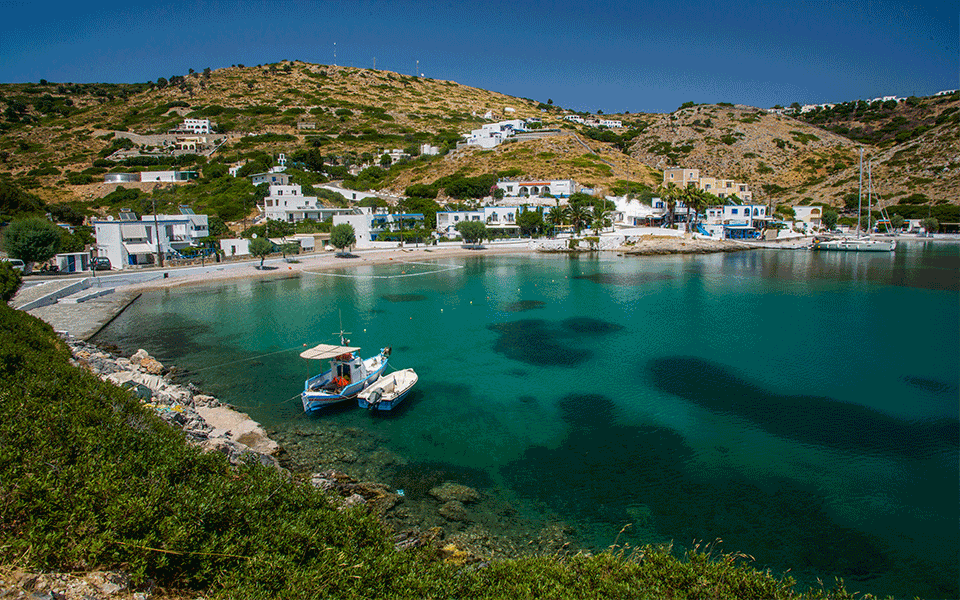
© Clairy Moustafellou
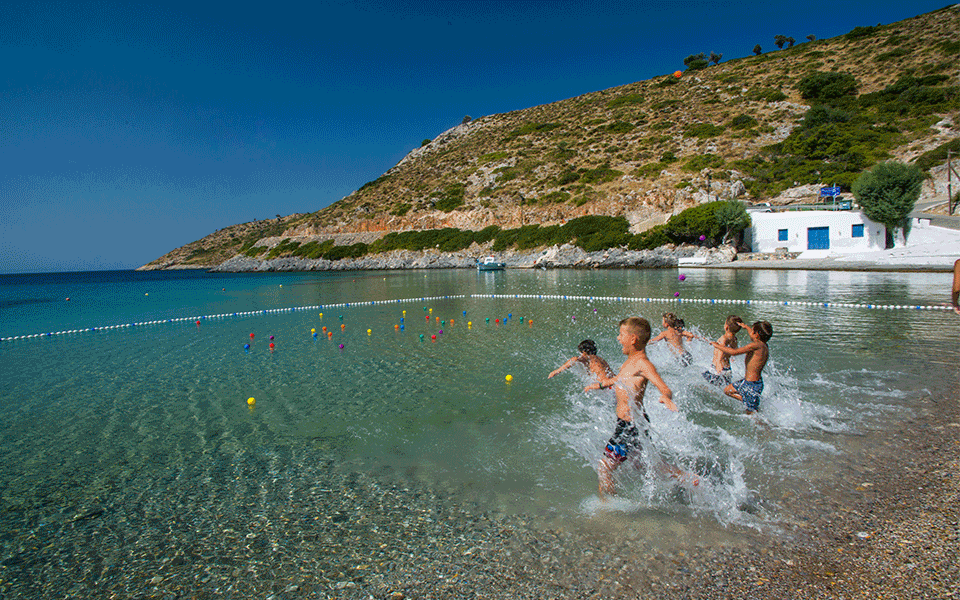
© Clairy Moustafellou
AGATHONISI
The next morning we set sail for Agathonisi. This makes no sense geographically speaking, but that’s the whole fun of being on a sailboat – you can go wherever you want, whenever you want. This island is pretty much the northernmost one in the whole Dodecanese group, lying next to Samos and in close proximity to the Turkish coast.
The wind is blowing 25 knots at 90 degrees to our course, and our sails are open. Beam-reaching (sailing perpendicular to the wind) is pure pleasure. Just before entering the harbor we are hit by the Agathonisi bougazi (a stiff wind channeled through a strait), which comes down directly from the unpredictable Icarian Sea. We rush to take in the sails. The four of us wrestle with ropes, as the cliffs loom menacingly closer. In these kinds of situations, if you’re an inexperienced sailor, you feel a bolt of panic. But then we cast a look at the captain, and his calm demeanor reassures us.
We struggle to find a space to moor in Agathonisi. Our only option is in front of the village, but the shallow waters here demand a lot of care. The fishing caiques moor on one side of the dock, passenger ships and port authority vessels on the other. There are two free spaces between the sections, and so we squeeze in there, mooring side-on. Water and electricity are available (10-euro cards can be bought from the nearby cafe), but these outlets are located quite far for cords and hoses to reach them.
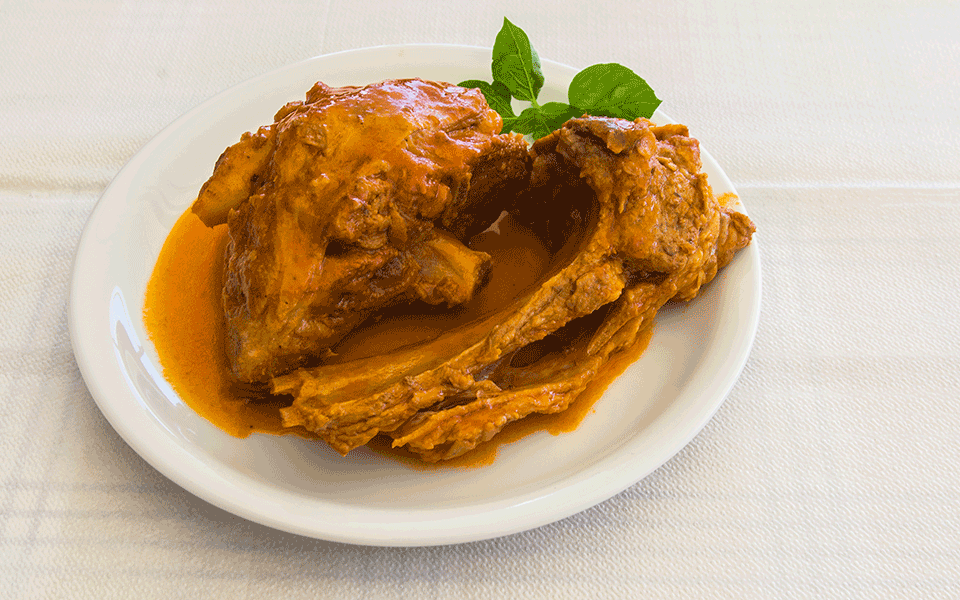
© Clairy Moustafellou
Agathonisi has about a hundred inhabitants, a couple of villages and a mayor. Cellphones here pick up telecom networks from Turkey. Most products are either local or brought over from the island of Samos. The people living here raise cows, goats and sheep, make cheese, they fish, and tend vegetable gardens. You can sample their products at tavernas like Yiorgos (tel +30 22470.291.01) and Atsidas (tel +30 22470.291.00). For breakfast, a coffee or a drink, head to Memento (tel +30 22470.290.19).
All of the island’s kids assemble at Aghios Georgios Beach to take part in the Stavros Niarchos Foundation’s “Athletic Trails” program, specially created for islands lying near the border. At nearby Spilia Beach, the tamarisk trees offer wonderful shade; however, we do come across a weever fish in its shallower waters.
The beaches of Palos and Vathy Pigadi are accessible on foot, and many people arrive by boat as well. At Katholiko we encounter local fishermen on their caiques and in their fishing huts, and at Kastraki we wander around the archaeological site of the ancient port, which was once the site of Tyrian purple dye workshops.
As we leave Agathonisi, Yiannis Yiamaios – the island violinist – comes out to bid us farewell, performing local melodies in the middle of the street.
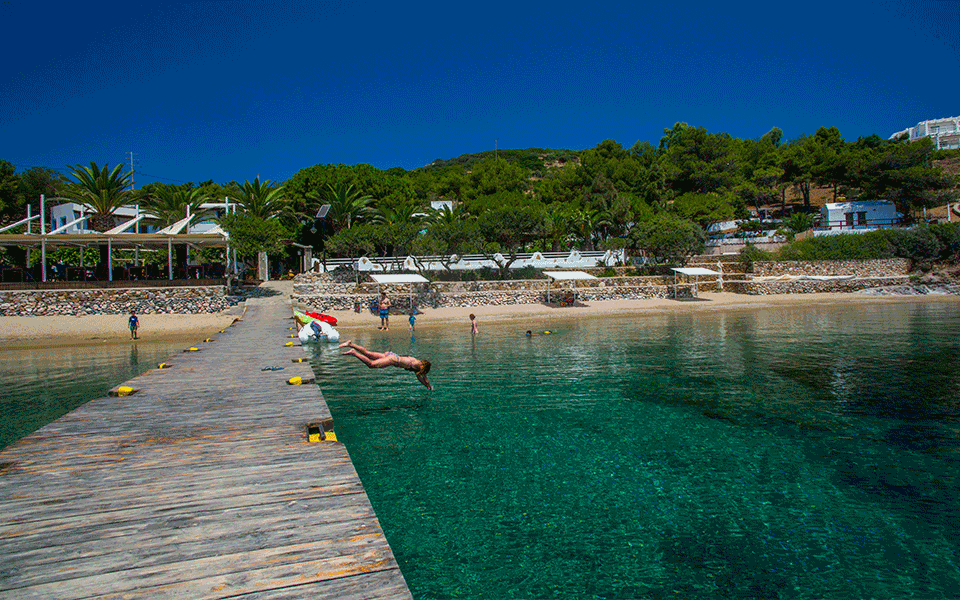
© Clairy Moustafellou
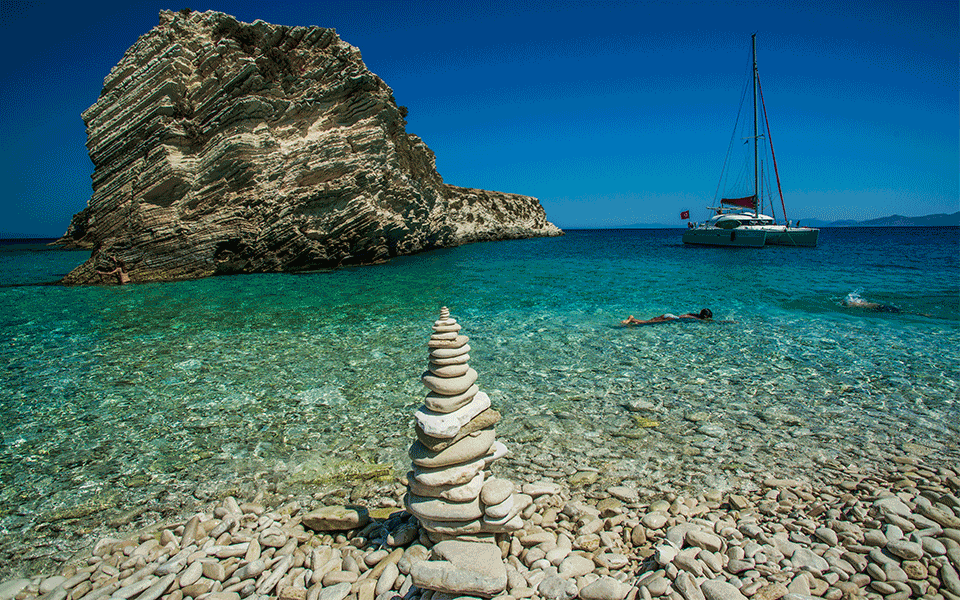
© Clairy Moustafellou
MARATHI: HERMITS IN PARADISE
“Marathi, this is the sailboat Johnny, do you copy?”
Menelaos is on the radio struggling to contact the island, in order to find out more about the available berths there. The local restaurateurs have installed VHFs supposedly for that purpose. We never get a response, but soon discover that Marathi essentially has no pier. There’s not much reason for them to have one anyway, as passenger ships don’t stop at the island. There’s just a little jetty where a few inflatable boats and excursion vessels can dock; most vessels anchor offshore.
What is Marathi, then? Well, it’s a beach! In fact, a sandy one with shallow waters that deepen gradually, and with tamarisk trees that offer shade. There are also three tavernas, and the little church of Aghios Nikolaos lies some 10 minutes away. So, to sum up, it’s all about the sea and food, red moons and life without any superfluous luxuries.
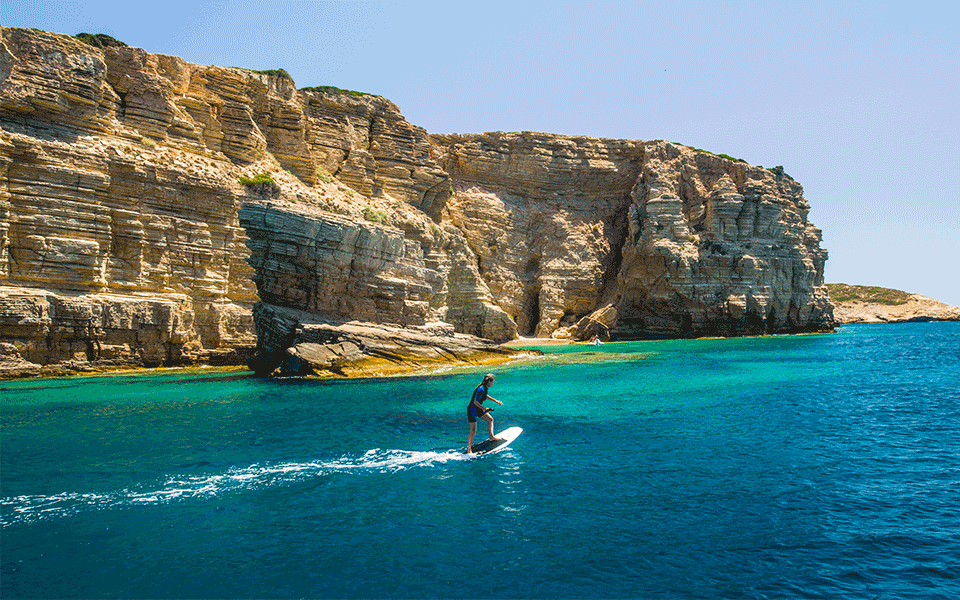
© Clairy Moustaafellou
Ditto for Aspronisia, the uninhabited islets to the northeast of Lipsi. For me, this is definitely one of the most beautiful spots in the whole of Greece. A snow-white beach with appealing limestone rocks and pebbles is formed at the point where two islets meet. When you take your dip you’ll see incredible azure, crystalline waters that will leave you utterly speechless – on account of both the beauty and the cold!
We could stay here for days, but our voyage continues towards Makronisi, another uninhabited islet that’s south of Lipsi. Alas, upon reaching this islet’s southern side (where we imagined we’d be alone), we come across practically every type of vessel imaginable.
Visitors drop anchor in the sandy depths and spend the whole day kayaking, SUPing, and diving off of cliffs. If you do decide to walk a bit along the coast, you’ll come upon an impressive shallow seawater lake filled.
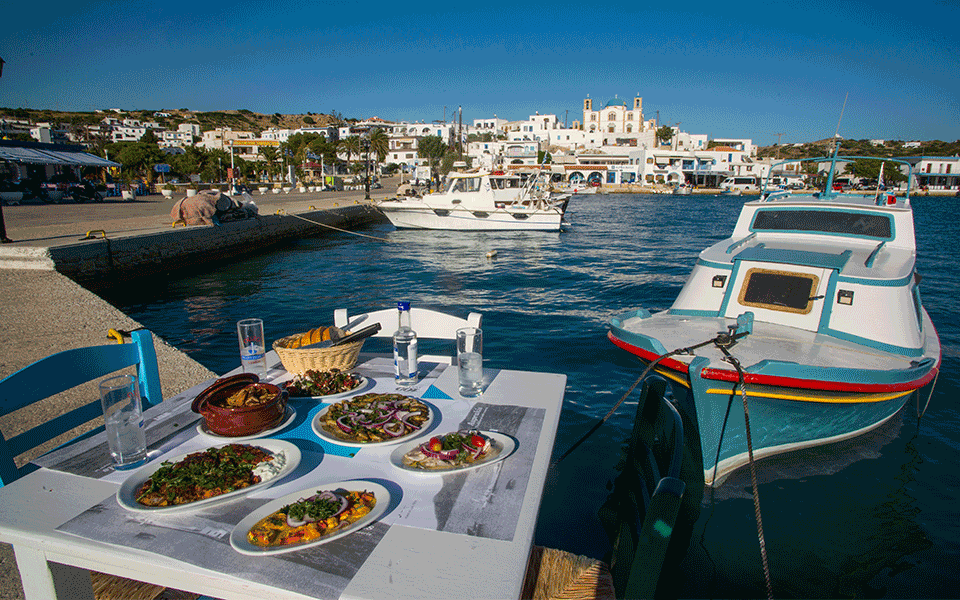
© Clairy Moustafellou
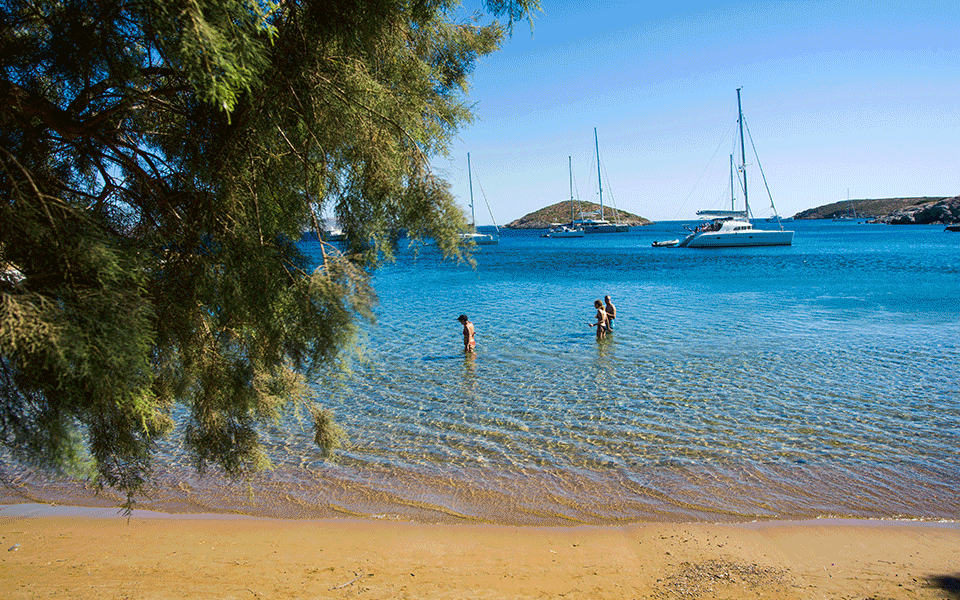
© Clairy Moustafellou
MISSING LIPSI ALREADY
“This is the knot that ‘untied’ the hands of seafarers,” says Captain Kostas, and by the time we reach Lipsi he’s already taught us how to tie the famous bowline. However, we don’t get to use it, as there are people waiting for us there. They help us moor the vessel, and immediately hook us up to electricity and water for a small fee. Things are pretty organized here, in comparison to the other islands in the area. All berths are occupied, so we end up mooring on the outer side of the pier. The strong wind that soon comes into the picture forces us to stay in Lipsi for two days.
This island is a favorite destination among both Greeks and Italians who make their way to its shores every summer. A spot that brings many visitors together is a little taverna called Asprakis (tel +30 22470.412.73), where Sivos and company not only serve you exceptional, homestyle mezes but also treat you like honored guests.
Another place to spend the whole day is a restaurant named Dilaila (tel +30 22470.410.41), located in Katsadia. It’s easy to while away the hours there swimming, enjoying good food and sipping cocktails. Other great locations for a dip are Platys Gialos and Hohlakoura, the latter with a small, secret beach with a cave situated nearby.
And that’s pretty much how our two days on the island pass: Spending time wandering around the village, joking with the members of the local theater group, who are full of enthusiasm, and horseback riding with Nektarios (tel +30 694.493.5475).
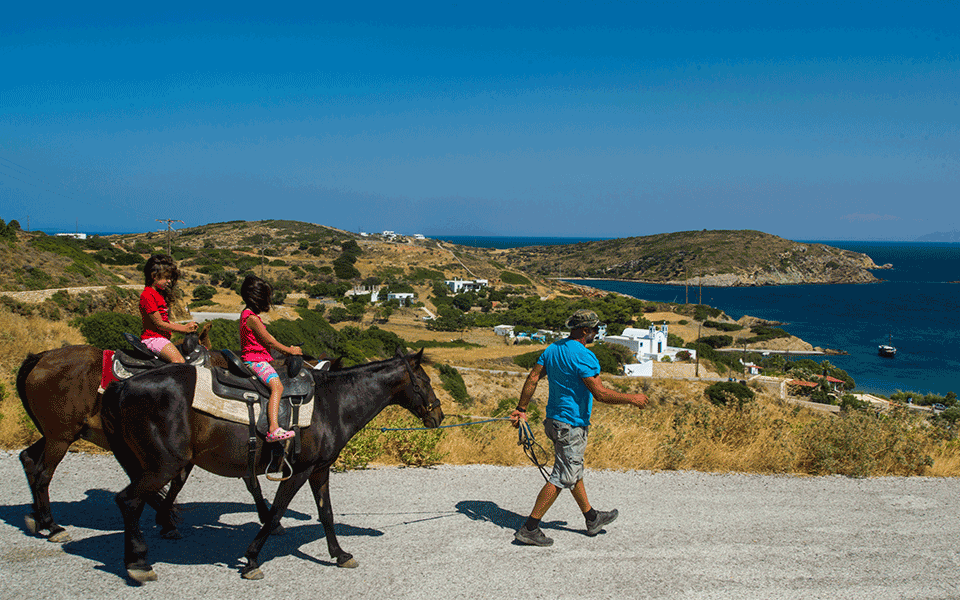
© Clairy Moustafellou
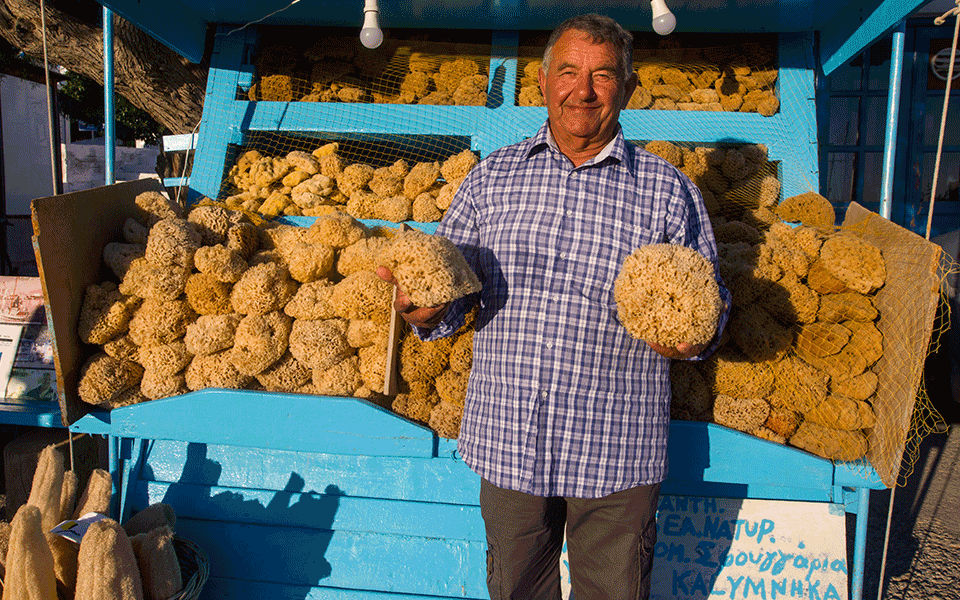
© Clairy Moustafellou
At the Alpha Farm (tel +30 22470.414.49) dairy, owned by the Italian Alessandro Baldissera, Maria Yiamaiou tells us all about the farm and their buffalo’s, goat’s and cow’s milk, with which they create their wonderful cheeses (graviera, kefalotyri, xinomizithra and caciotta, among others).
Inside the 17th-century church of Panaghia tou Harou (the Virgin Mary of Charon [Death]), Katerina informs us that this odd name originates from the icon of the Virgin Mary holding Christ crucified.
In the evening, we make our way to the winery on Lipsi (tel +30 22470.411.92), where we sample the island’s famous wine of the Fokiano variety. The sunset and the tidy, well-tended vineyard form the backdrop as we listen to mantinades (traditional rhyming couplets) delivered by Manolis Vavoulas, the owner.
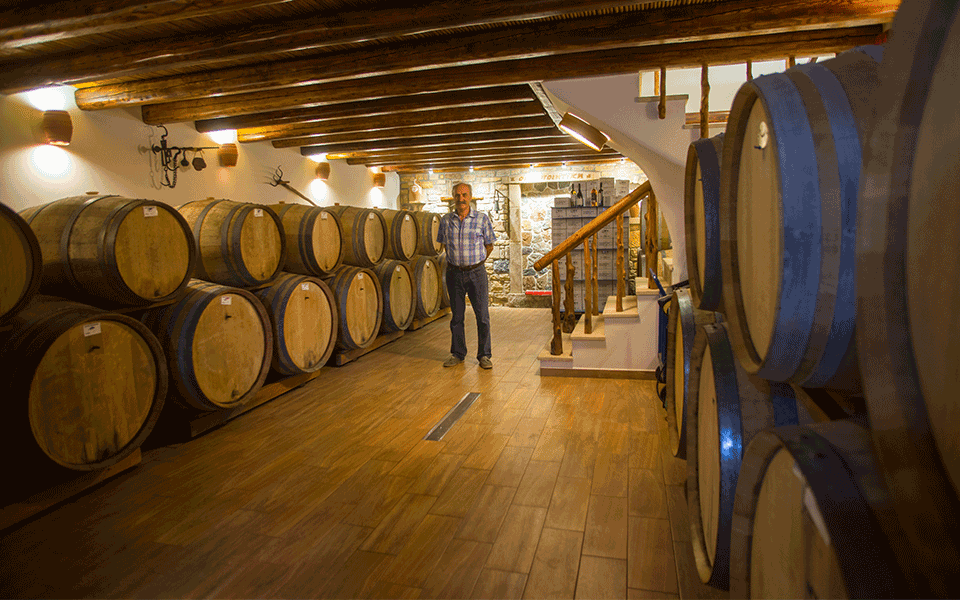
© Clairy Moustafellou
We spend our last night on the boat buffeted by a devilish mistral wind that causes the anchor to drag every so often, with sails squeaking and the vessel next to ours bumping against the pier. But there’s also local Fokiano wine and boat-prepared spaghetti, Kostas’ laouto (lute) and the voice of our songbird friend Nastazia Beikof, who we met there, accompanying the wind.
A few Lipsiotes are our guests, and our captain ends up staying on watch all night, as we sing songs with lyrics like trelos mousounas raghise mesonychtis ta relia (a mad monsoon cracked the rails at midnight), from Mousounas (Monsoon), a poem penned by the Greek poet Nikos Kavvadias.
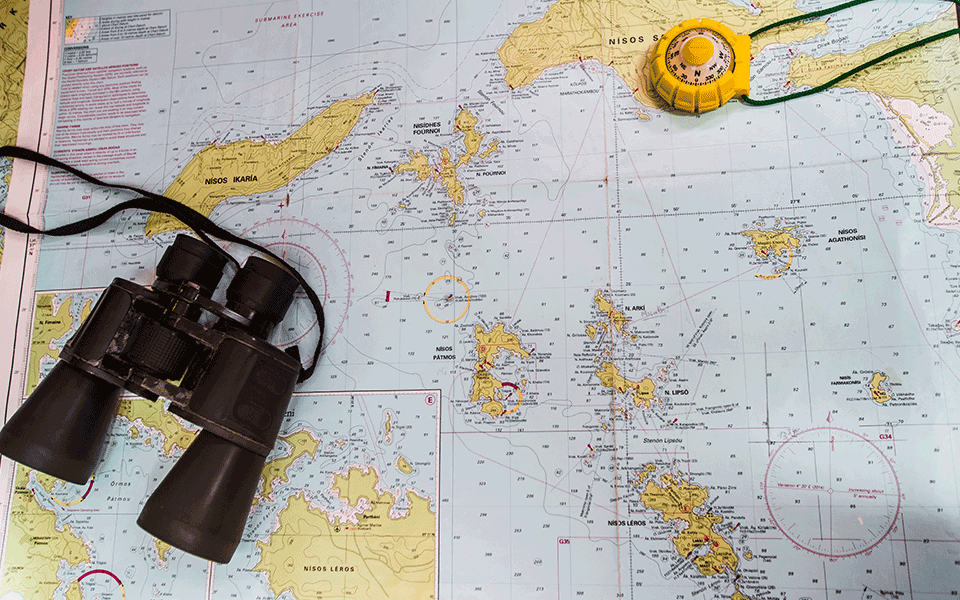
© Clairy Moustafellou
SAILING TRAILBLAZERS
Istion Yachting was founded in 1992 by Yiannis Kourounis, who also participated in the construction of the Kos marina as its project manager. Istion was one of the first pleasure boat rental companies in the area, and has contributed greatly to the promotion and development of this activity in the Dodecanese. It is also regarded as a pioneer in the provision of catamarans in Greece, promoting boating holidays among less experienced sailors.
Today, the company has six bases (Athens, Lavrio, Kos, Skiathos, Lefkada and Corfu), and a fleet of over 160 vessels (mainly monohulls, catamarans and cruisers) with an average age of just 4.6 years, and is regarded as one of the most dynamic yachting companies out there. It has won awards and has been certified by the largest international organizations.
Istion does not limit its activity to the fields of recreation and pleasure, however; it also actively supports competitive sailboat racing by organizing the “CATAMARANS CUP International Regatta”, sponsored by the Hellenic Match Racing Tour and held with the support of the Sailing Marathon.
Istion Yachting, Alimos head office, tel (+30) 210.981.1515.

